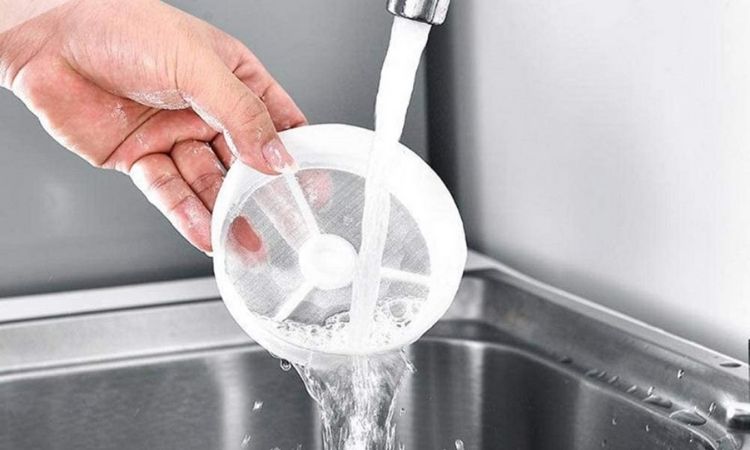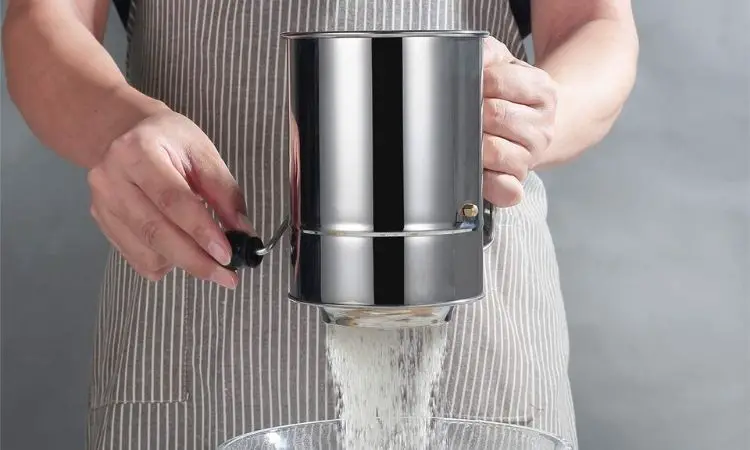
Do you really have to clean your flour sifter? Yes!
The good news is that it’s easy.
It’s the simplest task you can do in a day, but only if you have the time for it. Like about 2 minutes!
Doesn’t sound so bad, huh? So, shall we get on with the process?
Keep scrolling down!
Types of Flour Sifters
In the market, you may run into one or all of the following types of flour sifters. Let us discuss a little about them.
Manual vs. Electric
Flour sifters may be manual or electric. At the first look, you are probably assuming that electronic ones are better. But there’s something you need to know.
Manual flour sifters are cheaper than electric flour sifters, even though you have to sift dry ingredients manually. However, people with arthritis and other similar diseases will find the manual sifter difficult to operate, so they should get the electric device instead.
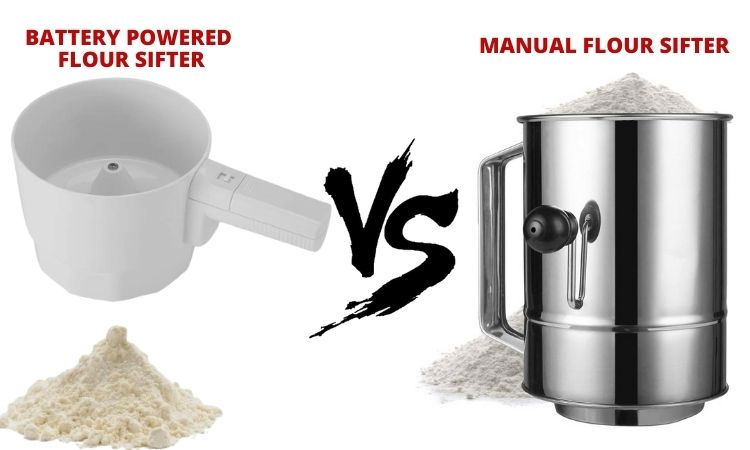
Moreover, manual sifters may be a squeeze-type or a crank-type. In a squeeze flour sifter, you have to squeeze the handle to filter the flour. You can do so with one hand.
On the other hand, you push a crank to sift flour in a crank flour sifter. This task doesn’t require much effort, so it’s a popular choice among lazy and physically ill people.
Plastic vs. Aluminum vs. Steel
Most of the flour sifters in the market are either made of plastic, aluminum, or stainless steel. The plastic sifters are the cheapest, but they break easily.
Aluminum sifters rust and dent easily. On the contrary, stainless steel flour sifters are durable, lightweight, maybe a little expensive, but won’t rust.
How to Clean a Flour Sifter Properly
Everybody will advise you to refrain from washing the flour sifter before using it. Since you are using fine ingredients, they will stick to the wet surface, and you won’t be getting any filtered mixture.
Therefore, prepare to wash the sifter after you are done sifting. It must be 100% dry before operation.
Just beware that cleaning a sifter may be challenging depending on the type of flour sifter you have. Truth be told, there are complex flour sifters in the market that are a headache to clean! The simple ones are not so bad though.
Let us share how you can clean different types of flour sifters.
Keeping Your Flour Sifter Clean
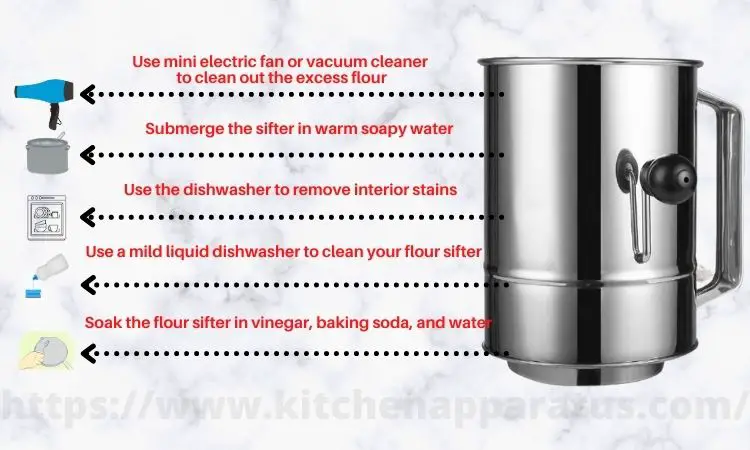
Manual Flour Sifter
To begin cleaning manual flour sifters like the rotary hand crank flour sifter and hand-held squeeze flour sifter, turn the cup upside down to remove excess flour.
Then, use a mini electric fan to fan out the nook and corner of the cup. You can even use a vacuum cleaner! Just make sure that the nozzle is clean before vacuuming the sifter. Store it for later use.
Besides, you must deep cleanse the manual flour sifter at least once a month for hygiene purposes. To do so, submerge the sifter in warm soapy water for 30 minutes.
After that, gently scrub the exterior and interior of the filter, even the mesh strainer inside. Be careful not to break the sifter mechanism of the squeeze and crank flour sifter. Therefore, be gentle and careful while scrubbing.
If your manual flour sifter has a complex construction that prevents your hands from reaching inside, use the dishwasher to remove interior stains. If you don’t have a dishwasher, you can just rinse without hand scrubbing.
Once you have rinsed it with clean water, dry it with a towel, then store it for later.
Electric Flour Sifter
Electric flour sifters need to be cleaned differently in comparison to manual sifters, especially due to its construction. They are battery-powered, so you can’t directly put the whole sifter into the dishwashing machine!
If the parts are separable, leave the battery-operated handle away from the dishwasher. Usually, the main body and the mesh are detachable and washable.
Wipe the handle only. Don’t let water get in!
If the parts are not separable, just scrub the cup and the interior without getting the handle wet. Store safely once it’s dry.
Plastic/Aluminum/Stainless Steel Flour Sifter
To clean a plastic, aluminum, or stainless steel flour sifter, you can apply the same techniques mentioned previously. Sometimes, people tend to use natural cleaning solutions over soapy water, for instance, vinegar, lemon, etc.
Washing plastic and stainless steel flour sifters with vinegar is fine, but not so for aluminum sifter as vinegar can cause corrosion on aluminum objects.
How to Remove Rust from a Flour Sifter
Your flour sifter can rust if it is made of aluminum. For this reason, we recommend our readers to purchase sifters that are made of stainless steel and tinned steel.
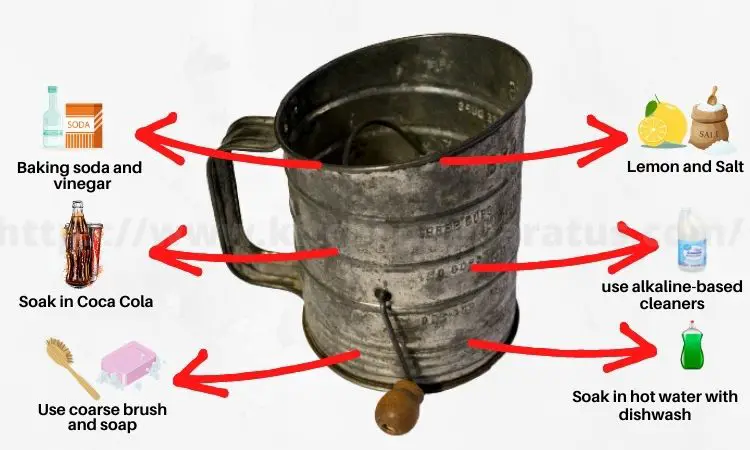
However, if you don’t want to part with your current sifter, follow our instructions below to remove rust for good! This procedure is important as you don’t want to eat rust with the food!
We have jotted out a few methods. Find the one that works for you!
- Soak the flour sifter in vinegar, baking soda, and water for about an hour. Add a tablespoon of vinegar, a teaspoon of baking soda to a container of water that the sifter can fit into.
- Later, scrub with steel wool to eliminate rust, and store after it has been wiped completely dry.
- The next method is to soak in Coca Cola. (You read that right!) Either submerge the sifter in the solution for an hour or more, then wipe dry with a towel.
- If stubborn rust still refuses to come off, soak the flour sifter in the vinegar-baking soda-water solution and Coca Cola overnight.
Avoid using aggressive degreasers like kerosene or WD40 to eliminate rust because they may contaminate your food. - Finally, if the flour sifter is heavily rusted, throw it away. Get one brand new!
Final Thoughts
So, did you find it difficult? Do you promise that you will spend a few minutes cleaning your flour sifter?
Yes, we understand that keeping each and every item in the house can be difficult. But if you do, the result is more rewarding than a dirty utensil that will be chucked away sooner than expected.
In order to make kitchenware last, we must properly care for them. In doing so, not only will you save money, but you will also feel a sense of accomplishment.

